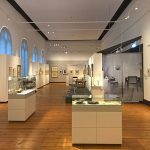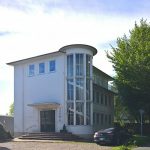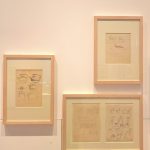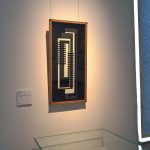Between Utopia and Adaptation. The Bauhaus in Oldenburg @ the Landesmuseum für Kunst und Kulturgeschichte Oldenburg
Sitting, quietly, unobtrusively, in the north-western corner of Germany, Oldenburg is, in many regards, a near textbook example of a provincial town. Which we don’t mean as an insult. Doesn’t mean it’s irrelevant. In any sense less worthy than elsewhere. Much more Oldenburg is the sort of self-contained community that exists not so much independent of the rest of the world, but without the rest of the world noticing. Or Oldenburg caring if they notice. Oldenburg has its (hi)stories, its intrigues, its characters, its dramas, its ways, its understandings, the sheer number of cafes in the pedestrianised town centre confirming that it does, and that is all important for Oldenburg. But Oldenburg is inconspicuous. Oldenburg isn’t the sort of place that is ever going to feature on the news, is never casually referenced in TV programmes, magazine articles or radio discussions, if they have a football team, then not one who play in a league you’ve ever heard of. Oldenburg is the sort of place one is from, but one would never move to. Respectable, decorous, correct, happy, unassuming. Provincial.
And thus surely not the sort of place to be troubled by something as radical, avant-garde and reformist as Bauhaus.
Surely……..
………………But yes.
And, as the exhibition Between Utopia and Adaptation. The Bauhaus in Oldenburg in the Landesmuseum für Kunst und Kulturgeschichte discusses, was not only troubled by, but actively contributed to.

Between Utopia and Adaptation. The Bauhaus in Oldenburg, Landesmuseum für Kunst und Kulturgeschichte Oldenburg
The (first tangible) result of a two and a half year research project by the Landesmuseum für Kunst und Kulturgeschichte Oldenburg under the guidance of exhibition curator Gloria Köpnick, Between Utopia and Adaptation. The Bauhaus in Oldenburg presents two central, intertwined, strands: the stories of five youngsters from Greater Oldenburg who studied at the Bauhauses, OK technically four youngsters from Greater Oldenburg, but we’ll get to that, and the Landesmuseum’s own relationship to Bauhaus as expressed, largely, through its collection, and a connection which in many regards, goes back to the establishing of the museum in 1921. Or more accurately put, slightly before: on April 26th 1919, and so just a matter of weeks after Gropius had been appointed Director of the newly formed school in Weimar, Walter Müller-Wulckow, the Landesmuseum’s founding Director, who at that point was still writing for the Frankfurter Zeitung, published, what is claimed to be, the first ever article about the new Gropius school. And an article which not only indicates Müller-Wulckow’s approval of the need for an institution such as Bauhaus, but his positive view of Gropius’s plans, or perhaps better put his congruity with Gropius: “Art is not a profession at all” he notes, thus perfectly echoing Gropius’s assertion in his April 1919 Bauhaus Manifesto that “There is no “profession of art””*. And a congruity and approval which not only implies Bauhaus has always enjoyed the unqualified, unfiltered, support of sections of the mass media, but logically led the Landesmuseum to begin collecting works by Bauhäusler shortly after Müller-Wulckow’s arrival in Oldenburg. Thus making the Landesmuseum für Kunst und Kulturgeschichte Oldenburg, along with institutions such as the Grassi Museum Leipzig or Neuen Sammlung Munich, one of the earliest institutional supporters of Bauhaus.
And it is with the striving for, as Müller-Wulckow phrases it, “the reunification of all disciplines of the material arts to a new art of architecture, whose inseparable components must be sculpture and painting, applied arts and craft….” as expressed at Bauhaus Weimar through works by the likes of, and amongst others, Wassily Kandinsky, Georg Muche or Werner Gilles, that Between Utopia and Adaptation opens, before moving on over a further dozen small, compact, chapters focussing on, for example, the Bauhaus Vorkurs, the Bauhaus workshops, or the Vereinigung für Junge Kunst [Association for Young Art], who between 1922 an 1933 organised exhibitions in Oldenburg by, and involving, the likes of Paul Klee, Oskar Schlemmer, Josef Albers, László Moholy-Nagy, et al, before ending by briefly following its various themes post-War, post-Bauhaus, including a brief discussion on Moholy-Nagy’s New Bauhaus in Chicago.

Between Utopia and Adaptation. The Bauhaus in Oldenburg, Landesmuseum für Kunst und Kulturgeschichte Oldenburg
In addition to illustrating its chapters through works by established Bauhaus protagonists such as those named above, Between Utopia and Adaptation also presents items, documents and works by the four central protagonists of the exhibition: Hans Martin Fricke who joined Bauhaus Weimar in 1922 aged just 16, worked in the carpentry workshop alongside the likes of Marcel Breuer or Erich Dieckmann, and who although moved with Bauhaus to Dessau never felt as at home there as he had in Weimar and so returned to Oldenburg where he qualified as an architect. Karl Schwoon and Hermann Gautel who both began their studies at the Oldenburg Werkhaus before, and both on the recommendation of Walter Müller-Wulckow, enrolling in Bauhaus Dessau: Schwoon specialising in murals, before returning to Oldenburg where he became a leading figure in the town’s art community, not least in context of the Vereinigung für Junge Kunst; Gautel working in the metal workshop, post-Dessau for the furniture manufacturer Albert Stoll in Waldshut, before returning to Oldenburg in 1933 where he established the furniture shop “für die wohnung….”, from where he sold, in addition to self-made wooden furniture, tubular steel objects from manufacturers such Thonet, WMF and Stoll, thereby bringing a breath of the new interior understandings to Oldenburg.
Born in nearby Aurich Hin Bredendieck first attended the applied arts colleges in Stuttgart and Hamburg before moving to Bauhaus Dessau where he worked in the metal workshop, alongside Hermann Gautel and Marianne Brandt. Post-Bauhaus Bredendieck initially worked for Moholy-Nagy and subsequently Herbert Bayer in Berlin before moving to Switzerland where he cooperated with Sigfried Giedion, until the expiry of his visa in 1934 saw him return to Oldenburg where he began designing furniture with Hermann Gautel. And Margarete Willers, the fifth of the four, and who after stations in Düsseldorf, Munich and Paris attended Bauhaus Weimar in 1921 and 1922, returning again in 1927 to Dessau where she worked as a freelancer in the weaving workshop’s Sample Studio, before moving on to Essen where she taught at the Folkwang Schule für Gestaltung from 1928 to 1943. Or put another way, Margarete Willers didn’t return to Oldenburg. Thus features less prominently in Between Utopia and Adaptation than the other four; which, yes, does make it a little bit of a case of a female Bauhäusler being (largely) left out of the narrative, again! However, on this occasion the absence is not the result of a blinkered, patriarchal understanding of society, far from it, much more is because she didn’t return to Oldenburg after Bauhaus, and thus doesn’t fully fit into the exhibition’s narrative, that of The Bauhaus in Oldenburg, the reality between the Utopia of Bauhaus and the necessary Adaptation to Oldenburg. The reality of Utopia in the Province.

Presentation of Margarete Willers, including a 1928/29 wall hanging, as seen at Between Utopia and Adaptation. The Bauhaus in Oldenburg, Landesmuseum für Kunst und Kulturgeschichte Oldenburg
For all the (relative) similarities of their Bauhaus lives, post-Bauhaus the four, male, protagonists followed different paths. Starting with very different ways through the war. Or not: Hermann Gautel being called up for military service in 1940, the last recorded sighting of him being in January 1945 near Kaliningrad. Something particularly galling, unfair, as he was briefly jailed in 1933 for communist sympathies. Hin Bredendieck emigrated to America in 1937 where he began to teach at the New Bauhaus in Chicago; Karl Schwoon joined the NSDAP in 1937, was called up in 1940, and spent the larger part of the war as a military photographer/photo-journalist on both the eastern and western fronts; Hans Martin Fricke joined the NSDAP in 1932, in 1935 was appointed head of the Reich Chamber of the Fine Arts for the region Weser-Ems, and was active as an architect, including contributing to numerous military projects, before in 1942 being called up, serving as Stabsfrontführer for Organisation Todt, a construction unit specialising in military infrastructures. And who we learn remained nicht entnazifiziert, a very poetic sounding phrase we always find, if one that by necessity implies unreformed, unrepentant.
Not that such hindered Hans Martin Fricke post-War in Oldenburg, where he served as chairman of the local branch of the Association of German Architects, BDA, from 1953 to 1976 and completed projects such as, and amongst others, the new headquarters of the AOK Oldenburg, the Peter Schütte fashion store, or offices for the construction company Ludwig Freytag. Whereby, one must add, Hans Martin Fricke is not the only German architect whose post-War career continued unhindered despite not only their war time activities but their continuing war time sympathies. In many regards the reconstruction of the 1950s would have been impossible without such. Which in no way excuses it.

A chair and tea table by Hans Martin Fricke (1925), as seen at Between Utopia and Adaptation. The Bauhaus in Oldenburg, Landesmuseum für Kunst und Kulturgeschichte Oldenburg
Having spent the final months of the War as a British prisoner, Karl Schwoon returned to Oldenburg where he continued to promote an avant-garde understanding of art, principally through his 1947 established galerie schwoon, before moving to first Hamburg in 1951 to work as a picture editor for Hörzu magazine and subsequently, and following his retirement in 1969, to Wildeshausen where he continued as an artist until his death in 1976.
Hin Bredendieck remained post-War in Chicago, teaching at the School/Institute of Design before in 1952 being appointed founding Professor of Industrial Design at the Georgia Institute of Technology in Atlanta. And for us the presentation of Hin Bredendieck’s works is one of the genuine joys of Between Utopia and Adaptation. Which isn’t to take anything away from the rest of the presentation; however, Hin Bredendieck is one of those Bauhäusler who regularly crops up in Bauhaus exhibitions, one whose path we have oft crossed, and that invariably, but invariably, in conjunction with Kandem lamps. Which are, equally invariably, included in Between Utopia and Adaptation, specifically as a series of 700er models developed in conjunction with Hermann Gautel and/or Marianne Brandt, and which express gradual changes to the design between 1928 and 1930. Yet through the presentation of his lighting designs with Sigfried Giedion for Swiss manufacturer B.A.G. Turgi, through his typography and artistic works, through the numerous sketches and plans for furniture designs, including those with Hermann Gautel, and through his design work in America with Nathan Lerner, including a flat-pack, self assembly chair from 1949 which never saw the light of day, but arguably should have. And may still. Hopefully unupholstered. If only there was a wooden furniture specialist in Ostfriesland, one ideally near Aurich, who could explore if such would be feasible, if only……..but we digress…. through the fulsome and varied presentation of Hin Bredendieck, Between Utopia and Adaptation ably demonstrates that he was much more than Kandem, was a much more interesting character and, as Between Utopia and Adaptation also deliciously indicates, one about whom there is a great deal more to be learned about and from.
Which leads one naturally to the question, did Oldenburg learn from Hin Bredendieck? Or Hans Martin Fricke, Karl Schwoon or Hermann Gautel? Or put another way, Bauhaus may have been in Oldenburg, but was Oldenburg listening? Or was it too consumed in its own intrigues, dramas and cafes?
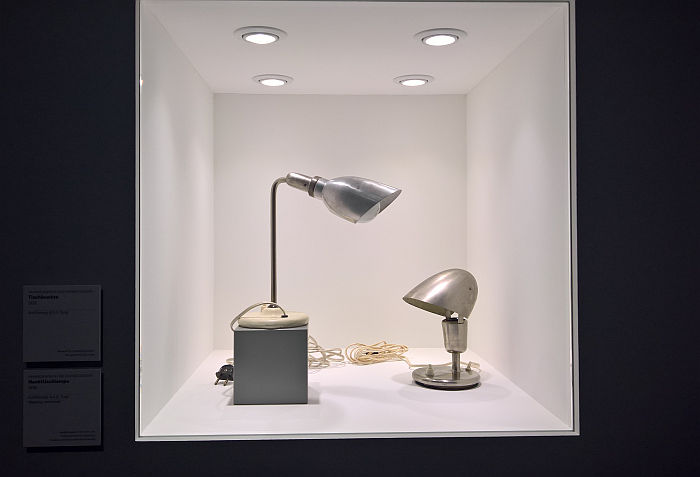
Two lamp designs by Hin Bredendieck and Sigfried Giedion for B.A.G. Turgi (1932), as seen at Between Utopia and Adaptation. The Bauhaus in Oldenburg, Landesmuseum für Kunst und Kulturgeschichte Oldenburg
That from the four Hans Martin Fricke was active in Oldenburg for the longest could, in context of such a question, be viewed as unfortunate, not only on account of his NSDAP sympathies, but because he, essentially, denied his Bauhaus past, apparently rarely speaking of it post-War and when, then in derogatory terms. And while the office building for Ludwig Freytag from 1954/55 demonstrates in the stairwell a nice organic curvature, arguably a juxtapose of geometric forms very much akin to Weimar Bauhaus, the majority of his Oldenburg work, at least that which we’re aware off, is, for us, while rational, much more the conservative Stuttgarter School rational than the avant-garde Bauhaus School rational. The biggest influence therefore could/would arguably have been Karl Schwoon, and thereby principally artistic influences rather than the “How do we want to live” that is so often discussed in connection with Bauhaus. Of which Hermann Gautel’s furniture shop and Gautel/Bredendieck’s furniture designs must be considered the best examples.
That “für die wohnung….” existed but for a few inter-War years and galerie schwoon but for a few post-War years tending to imply a restricted influence, and we certainly didn’t see anything in the exhibition, nor on the streets of Oldenburg, to indicate any of the four was the author of a radical change; however, there are a couple of petrol stations in Oldenburg with organic, mushroom-esque roofs which imply their spiritual origins are further afield, while we learn from Between Utopia and Adaptation, learn en passant one must add, that there existed once in Oldenburg the Wolters steel tube furniture factory. A steel tube furniture factory in Oldenburg! In how far Gautel and Bredendieck were responsible, we no know. We don’t even know when the factory was operational, even Dr Google having no knowledge of it.
What is however clear, and neatly explained in the course of Between Utopia and Adaptation, is that actively three of the four plus the Landesmuseum, passively one of the four, did bring the thinking, positions and understandings of the inter-war Modernist out into the German province, and thus made it tangible for a public beyond the cosmopolitan elites in a Berlin, a Frankfurt or a Dresden. And that must have had some influence, not least because through “für die wohnung….”, galerie schwoon and the Vereinigung für Junge Kunst one sees, understands, there was a receptive and appreciative audience.
What Between Utopia and Adaptation doesn’t discuss is those who were inspired and influenced by the Bauhäusler, how the ideas and positions Fricke, Gautel, Schwoon and Bredendieck brought with them, how those ideas and positions exhibited in and promoted by the Landesmuseum, were taken up by a new generation of post-War Oldenburg creatives, if you will, how the story continued; but not only is and was that not the focus of Between Utopia and Adaptation, but it sounds like a subject for a future exhibition. As does Margarete Willers. Fair’s fair.
Presenting primarily paintings, prints, photographs, sketches, plans, documents and similar wall mounted objects, Between Utopia and Adaptation takes the visitor on an essentially chronological tour through the lives of Messrs Fricke, Gautel, Schwoon and Bredendieck, bilingual German/English texts introducing the various chapters as one progresses, while the parallel presentation of objects from the museum’s collection not only nicely setting the works in a wider context, but also allowing for a pleasing change of perspective from focussed to general, focussed to general, focussed to general, focussed to……
And thus a presentation concept which although allowing for a coherent, rounded, entertaining and informative introduction to not only the four but also Bauhaus in Oldenburg, albeit one must add a very male Bauhaus in Oldenburg, aside from Willers and Brandt you’ll hunt long and hard to find other female Bauhäusler represented, can do no more than introduce its numerous subjects, simply cannot allow for deeper investigations; and a state of affairs escalated by the fact that in many cases there aren’t complete archives one can refer to, much of the work, much of the documentation that one would need for a deeper investigation, simply doesn’t exist. Making that which does exist all the more important, the narratives in Between Utopia and Adaptation helping as they do to expand the Bauhaus biography, something continued in the exhibition catalogue through the persons of the Oldenburger Milon Harms who studied in Dessau, and post-Bauhaus was active in Magdeburg and Freiburg im Breisgau, or the artist Johannes Karl Hermann, one of the earliest students at Bauhaus Weimar and who in 1955 left the DDR and settled in Oldenburg, and who is also represented in the exhibition.
And thus something which for us is very important to achieve this year, to achieve an understanding of Bauhaus based on a much wider number of biographies than those exalted few who currently define the schools. Because through such one can, hopefully, approach a more realistic, probable, understanding of Bauhaus, one can demystify Bauhaus, can free it from its singular, venerated, status and accept that like any school Bauhaus is no more than the sum of its staff and students, that Bauhaus is/was a mix of individuals, individuals with individual perspectives, individual positions, individual politics, individual talents, individual abilities, individual backgrounds, individual dreams and awaiting individual futures; that a Bauhaus eduction could be the start of a stellar international career, could see you regularly referenced in TV programmes, magazine articles, radio discussions. A Bauhaus education could also mean working for a TV listings magazine, could mean a small, regional, architectural office, a pedagogical career, or a biography cut short, who knows where, who knows when. Which doesn’t make such biographies irrelevant, in any sense less worthy than others. Just inconspicuous. But uneqivocally “inseparable components” of Bauhaus, and thus well worth seeking out and exploring.
And where better to do that, and to begin to move towards a healthier understanding of Bauhaus, than in a respectable, decorous, correct, happy, unassuming town in the north-western corner of Germany.
Between Utopia and Adaptation. The Bauhaus in Oldenburg runs at the Landesmuseum für Kunst und Kulturgeschichte, Augusteum, Elisabethstraße 1, 26135 Oldenburg until Sunday August 4th.
Full details, including information on the accompanying fringe programme, can be found at www.landesmuseum-ol.de
* In the interests of completion, and for all Germanophones, the original quotes are “Kunst ist überhaupt kein Beruf” (Walter Müller-Wulckow), “Denn es gibt keine „Kunst von Beruf“” (Walter Gropius)
- Between Utopia and Adaptation. The Bauhaus in Oldenburg, Landesmuseum für Kunst und Kulturgeschichte Oldenburg
- Sketches by Oskar Schlemmer for costumes for the 1928 ballet, Spielzeug, as seen at Between Utopia and Adaptation. The Bauhaus in Oldenburg, Landesmuseum für Kunst und Kulturgeschichte Oldenburg
- War time photos by Karl Schwoon, as seen at Between Utopia and Adaptation. The Bauhaus in Oldenburg, Landesmuseum für Kunst und Kulturgeschichte Oldenburg
- Lamps by Hin Bredendieck, Hermann Gautel and Marianne Brandt for Kandem viewing Bredendieck’s extended canon, as seen at Between Utopia and Adaptation. The Bauhaus in Oldenburg, Landesmuseum für Kunst und Kulturgeschichte Oldenburg
- Lamps by Hin Bredendieck, Hermann Gautel and Marianne Brandt for Kandem, as seen at Between Utopia and Adaptation. The Bauhaus in Oldenburg, Landesmuseum für Kunst und Kulturgeschichte Oldenburg
- A photo by Marianne Brandt and paintings by Paul Klee, Oskar Schlemmer and Karl Schwoon, as seen at Between Utopia and Adaptation. The Bauhaus in Oldenburg, Landesmuseum für Kunst und Kulturgeschichte Oldenburg
- Office building for Ludwig Freytag by Hans Martin Fricke, 1954/55
- Plans by Karl Schwoon from his studies at Bauhaus Dessau, as seen at Between Utopia and Adaptation. The Bauhaus in Oldenburg, Landesmuseum für Kunst und Kulturgeschichte Oldenburg
- Sketches for chairs and a kettle by Hin Bredendieck, as seen at Between Utopia and Adaptation. The Bauhaus in Oldenburg, Landesmuseum für Kunst und Kulturgeschichte Oldenburg
- Between Utopia and Adaptation. The Bauhaus in Oldenburg, Landesmuseum für Kunst und Kulturgeschichte Oldenburg
- A glass relief by Josef Albers (1928), as seen at Between Utopia and Adaptation. The Bauhaus in Oldenburg, Landesmuseum für Kunst und Kulturgeschichte Oldenburg
- Furniture and interior sketches by Hans Martin Fricke, as seen at Between Utopia and Adaptation. The Bauhaus in Oldenburg, Landesmuseum für Kunst und Kulturgeschichte Oldenburg
- Between Utopia and Adaptation. The Bauhaus in Oldenburg, Landesmuseum für Kunst und Kulturgeschichte Oldenburg
- Between Utopia and Adaptation. The Bauhaus in Oldenburg, Landesmuseum für Kunst und Kulturgeschichte Oldenburg
- Between Utopia and Adaptation. The Bauhaus in Oldenburg, Landesmuseum für Kunst und Kulturgeschichte Oldenburg
Tagged with: Bauhaus, Between Utopia and Adaptation, Hans Martin Fricke, Hermann Gautel, Hin Bredendieck, Karl Schwoon, Margarete Willers, Oldenburg

